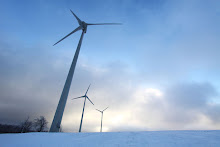Electric transmission is the movement of large amounts of electricity over long distances. In this process electricity is moved from a central generating unit to an interconnection with an electrical distribution system, or in some cases, directly to industrial customers. The transmission system is the electrical highway that connects supply to demand across a network called an electric grid. Different entities define the facilities that comprise the transmission system somewhat differently, but transmission generally refers to any electric line with voltage greater than 60 kV (some entities use 40 kV as the break, some 115 kV). Typical transmission voltages include 69, 115, 128, 230, 345, 500, and 765 kV. Transmission lines can be designed to transmit either AC (alternating current) power or DC (direct current) power, but not both. Most lines in the U.S. are AC.
The Transmission System
Generation: Generator
Transmission: Station transformer and switchyard - Transmission substation
Distribution: Distribution substation
North American Power Grids
Western Interconnect
Eastern Interconnect
Texas Interconnect
Quebec Interconnect
Ownership of Transmission
Until the advent of electric restructuring in the U.S., transmission lines were owned by vertically-integrated utilities or by federal generation agencies. As restructured electric markets have evolved, some utilities have concluded that it no longer makes sens to own transmission lines, and have sold theirs to transmission companies (also referred to as transcos). A transco is a stand-alone owner and operator of transmission facilities. Many industry observers believe that over time we will evolve to a market structure where transmission ownership and operation is dominated by transcos. This is similar in structure to the current U.S. interstate natural gas transmission system, where investor-owned companies own and operate interstate pipelines as a stand-alone business.
skip to main |
skip to sidebar
Energy Forecast & Updates
